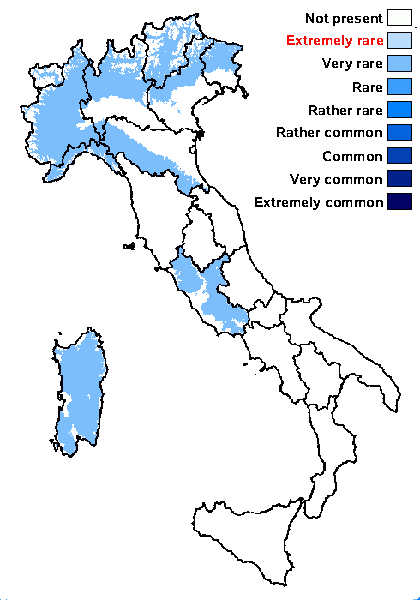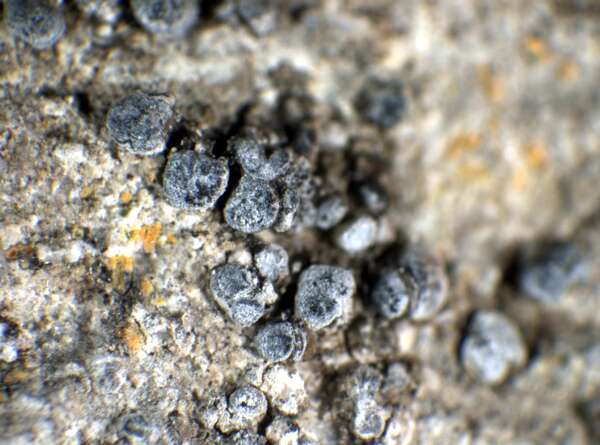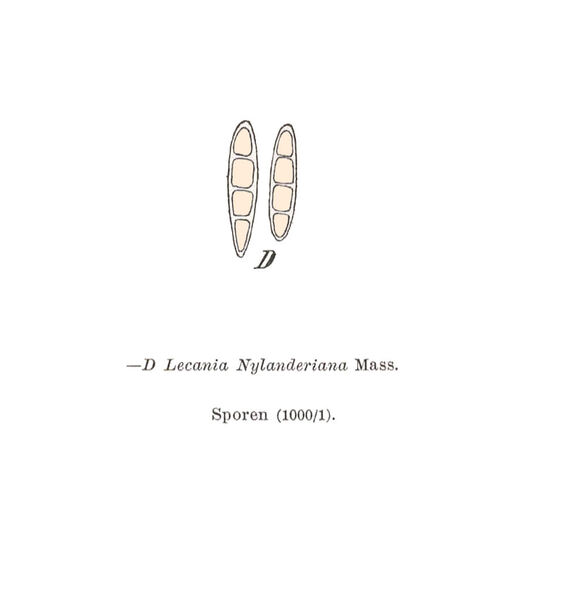Lecania nylanderiana A. Massal.
Sched. Crit., 8: 152, 1856.
Synonyms: Lecania athroocarpa Trevis.; Lecania odora Bagl. & Carestia?; Lecanora athroocarpa Nyl.
Distribution: N - Frl, Ven (Lazzarin 2000b, Nascimbene 2005c, 2008c, Watson 2014), TAA (Nascimbene & al. 2006), Lomb (TSB 21823), Piem (Isocrono & al. 2004), VA (Piervittori & Isocrono 1999), Emil (Fariselli & al. 2020), Lig. C - Laz, Sar.
Description: Thallus crustose, episubstratic, thin, of sharply angular, flat areoles, whitish, pale grey to grey-brown, without a distinct prothallus. Apothecia lecanorine, 0.3-0.8 mm across, usually crowded and often deformed by mutual compression, with a dark brown to black, but always whitish pruinose, flat to slightly convex disc and a grey-pruinose thalline margin. Thalline exciple clearly lecanorine, best developed in basal parts, the cortex with a network of narrow hyphae, the medulla rich in algae; proper exciple thin to moderately thick, pale to dark brown in outer part, paler within; epithecium patchily dark brown, with an epipsamma; hymenium colourless or yellowish in upper part, 60-80 µm high; paraphyses coherent, the apical cells swollen, up to 6 µm wide. Asci 8-spored, narrowly clavate, with a K/I+ blue tholus and a central non-amyloid area, Bacidia-type. Ascospores 3-septate, hyaline, ellipsoid with rounded ends, 12-16(-18) x 4-5 µm, thin-walled, without a gelatinous perispore. Photobiont chlorococcoid. Spot tests: thallus K-, C-, KC-, P-, UV-. Chemistry: without lichen substances. Note: a temperate species found on vertical to rain-sheltered surfaces of calcareous rocks. Several Italian records need confirmation.
Growth form: Crustose
Substrata: rocks
Photobiont: green algae other than Trentepohlia
Reproductive strategy: mainly sexual
In underhangs rarely wetted by rain
Commonnes-rarity: (info)
Alpine belt: absent
Subalpine belt: absent
Oromediterranean belt: absent
Montane belt: very rare
Submediterranean belt: very rare
Padanian area: absent
Humid submediterranean belt: very rare
Humid mediterranean belt: absent
Dry mediterranean belt: absent

Predictive model
Herbarium samples
Growth form: Crustose
Substrata: rocks
Photobiont: green algae other than Trentepohlia
Reproductive strategy: mainly sexual
In underhangs rarely wetted by rain
Commonnes-rarity: (info)
Alpine belt: absent
Subalpine belt: absent
Oromediterranean belt: absent
Montane belt: very rare
Submediterranean belt: very rare
Padanian area: absent
Humid submediterranean belt: very rare
Humid mediterranean belt: absent
Dry mediterranean belt: absent

Predictive model
| Herbarium samples |
 INDEX FUNGORUM
INDEX FUNGORUM
 GBIF
GBIF
 DOLICHENS
DOLICHENS




